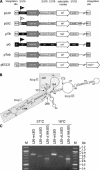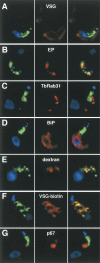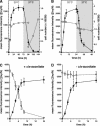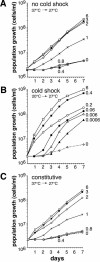Cold shock and regulation of surface protein trafficking convey sensitization to inducers of stage differentiation in Trypanosoma brucei
- PMID: 15545633
- PMCID: PMC528899
- DOI: 10.1101/gad.323404
Cold shock and regulation of surface protein trafficking convey sensitization to inducers of stage differentiation in Trypanosoma brucei
Abstract
Transmission of a protozoan parasite from a vertebrate to invertebrate host is accompanied by cellular differentiation. The signals from the environment that trigger the process are poorly understood. The model parasite Trypanosoma brucei proliferates in the mammalian bloodstream and in the tsetse fly. On ingestion by the tsetse, the trypanosome undergoes a rapid differentiation that is marked by replacement of the variant surface glycoprotein (VSG) coat with GPI-anchored EP and GPEET procyclins. Here we show that a cold shock of DeltaT > 15 degrees C is sufficient to reversibly induce high-level expression of the insect stage-specific EP gene in the mammalian bloodstream stages of T. brucei. The 3'-UTR of the EP mRNA is necessary and sufficient for the increased expression. During cold shock, EP protein accumulates in the endosomal compartment in the proliferating, slender, bloodstream stage, whereas the EP is present on the plasma membrane in the quiescent, stumpy, bloodstream stage. Thus, there is a novel developmentally regulated cell surface access control mechanism for a GPI-anchored protein. In addition to inducing EP expression, cold shock results in the acquisition of sensitivity to micromolar concentrations of cis-aconitate and citrate by stumpy but not slender bloodstream forms. The cis-aconitate and citrate commit stumpy bloodstream cells to differentiation to the procyclic stage along with rapid initial proliferation. We propose a hierarchical model of three events that regulate differentiation after transmission to the tsetse: sensing the temperature change, surface access of a putative receptor, and sensing of a chemical cue.
Figures








 ,
,  , or checkpoint-like control
, or checkpoint-like control  . Crosses symbolize surface proteins (including EP and the putative citrate receptor) up-regulated by cold shock. The model does not exclude the participation of intracellular cold-induced proteins.
. Crosses symbolize surface proteins (including EP and the putative citrate receptor) up-regulated by cold shock. The model does not exclude the participation of intracellular cold-induced proteins.References
-
- Alexander D.L., Schwartz, K.J., Balber, A.E., and Bangs, J.D. 2002. Developmentally regulated trafficking of the lysosomal membrane protein p67 in Trypanosoma brucei. J. Cell Sci. 115: 3253-3263. - PubMed
-
- Bangs J.D., Uyetake, L., Brickman, M.J., Balber, A.E., and Boothroyd, J.C. 1993. Molecular cloning and cellular localization of a BiP homologue in Trypanosoma brucei. Divergent ER retention signals in a lower eukaryote. J. Cell Sci. 105: 1101-1113. - PubMed
-
- Barry J.D. and McCulloch, R. 2001. Antigenic variation in trypanosomes: Enhanced phenotypic variation in a eukaryotic parasite. Adv. Parasitol. 49: 1-70. - PubMed
Publication types
MeSH terms
Substances
LinkOut - more resources
Full Text Sources
Other Literature Sources
